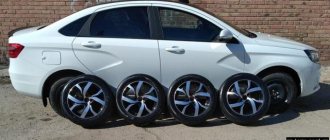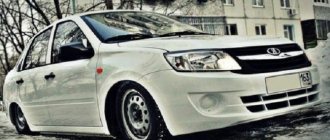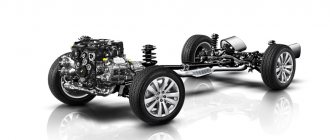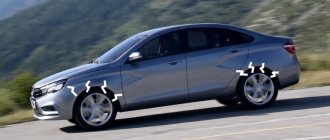Even at the stages of car development, it was known that the Vesta platform would be truly new, and not just another modernization of the VAZ 2108 suspension. Now that serial production of the sedan has already started, and the first samples have already been on test drives in various car magazines, more detailed details are being clarified about the chassis of the Lada Vesta.
The last adjustments to the suspension characteristics took place in winter in Spain, at the IDIADA training ground. Then a balance was found between comfort and car controllability. What happened?
Lada Vesta front suspension design
The supporting structure is based on a subframe, which is an innovation for the domestic automobile industry. Also, for the first time, the L-shaped levers were used.
The subframe performs the additional function of strengthening the body, giving it strength, and preventing deformation on uneven surfaces. As a result, the overall safety score was increased by five points.
In general, the suspension design is quite simple and in many ways similar to Renault Logan and Renault Duster of the second generation. Carrying out preventive maintenance does not require additional costs. The steering gear is now secured to the bottom of the engine compartment.
Independent suspension
From a physical point of view, the “low” position of the rack provides maximum connection with the steering knuckle. An electric amplifier is pre-installed on the rail, which was not previously in the design of VAZs. The shape of the transverse stabilizer has been redesigned to improve the “feel” when turning the steering wheel. The castor (tilt) angle is 5°, independent suspension, MacPherson struts, which together make the car smoother.
Features of the suspension on LADA Vesta
Having read the reviews about the suspension, we can say with confidence that the innovations used in the design are aimed primarily at the quality of vehicle handling, safe driving and passenger comfort. However, not all reviews are positive; during operation, extraneous noise appears in the rear suspension.
Some dealerships suggest installing shims on the rear shock absorber. To diagnose the performance of the suspension yourself, you need to hang the car. In this case, the front wheels should not touch the surface. By moving the wheel in both planes, we determine the play:
- When the brake pedal is released, play is felt - the front hub bearing is worn out;
- Play is felt when the brake pedal is pressed and released - the suspension is faulty;
- If the rack is poorly secured or the ball joint is worn, play is felt in the vertical plane;
- If there is horizontal play, the tie rod end (front suspension module) has failed.
Creaking and knocking noises can be caused by the bushings not being lubricated or the rear shock absorber not having a washer.
The last adjustments to the suspension characteristics took place in winter in Spain, at the IDIADA training ground. Then a balance was found between comfort and car controllability. What happened?
The Spanish testing ground IDIADA was chosen for the final configuration of the car parameters. The manufacturer's goal was to achieve the greatest possible interaction between the driver and the vehicle, and he really succeeded:
- the car moves confidently in a straight direction, while the driver accurately feels when the steering wheel is in the zero position;
- when cornering on uneven sections of the track, the steering wheel does not vibrate, and this guarantees constant feedback between the driver and the car;
- accelerating the car while entering a turn, the driver does not feel shaking;
- The new Lada model has a suspension that provides for the use of electronic systems - EBD, ABS and ESP. Thanks to the built-in stabilization system, control during a skid or drift is facilitated; the driver has full control of traction;
- The versatile Vesta has excellent cross-country ability, on the one hand, thanks to the correct suspension settings, and on the other, due to high-quality electronics. In order to overcome off-road areas, the manufacturer installed an imitation of differential locks - a new product for AVTOVAZ, which the owners have already noted as an improvement.
Suspension features
The front suspension is based on gas-filled double-sided shock absorber struts, on which a series of coil springs, barrel springs and lower arms are installed. Stabilizers are located on pyramids. The longitudinal extensions from previous versions have been replaced by universal, L-shaped arms that can withstand heavy loads in any direction thanks to a five-degree caster.
Studying the part in detail, one can note something in common with the way the front-wheel drive of Renault cars is designed. An interesting feature is the presence of a subframe, thanks to which the car has two points of support for stretch marks.
Special attention is paid to the rear suspension, in which the mechanism installed in RenaultZoo electric vehicles has been redesigned. Semi-independent suspension models differ from versions with extended beams; the suspension has longitudinal linked arms
The manufacturer decided to limit itself to installing domestic struts, and the shock absorbers were located in the arch, which increased driving comfort and safety. The spars reliably cover each rear suspension spring, which also increases ease of movement.
Rear suspension device
The food is borrowed from the French brand Renault Logan of the second generation. The design is typical - a transverse metal beam with springs spaced on the sides.
The brake system is of a drum type, which was expected, since disc mechanisms would increase the cost of the model by 3 - 4%. In general, the “drums” do an excellent job of the task at low and medium speeds.
Design (diagram):
- Levers.
- Gaskets for springs.
- Upper support.
- Compression buffer.
- Gas shock absorber.
- Hub axis.
- Brake drum.
- The wheelbase is extended to 1510 mm.
The most common Vesta suspension failures
If the Lada Vesta suspension is knocking, then the reason, first of all, should be sought in the shock absorbers; they are the ones that most often cause such sounds. If you decide to check the integrity of the shock absorbers yourself, then hurry to do this immediately after stopping so that the liquid in them does not have time to cool. Rock the car; a good shock absorber will not allow the body to oscillate more than 2-3 times.
Another reason for “incomprehensible” knocking noises may be wheel bearing play. To check the play, you need to hang the wheel and shake it from side to side. If the wheel play is large, then it is time to change the bearing.
The creaking of the Lada Vesta suspension may mean a lack of lubrication in the supports or bushings of the strut. Such sounds can be caused by poor lubrication of the shock absorber mounting. This must be remembered so as not to disassemble half of the suspension in search of a squeak.
Owners who often use Vesta on dirt roads often hear a creaking noise coming from the rear suspension. Most likely, it is caused by foreign objects (small stones, etc.) getting between the brake pads and the disc.
How can you determine which suspension on the Lada Vesta is reliable or not? Only time will tell, because the car is quite new and still quite “untested”. Accurate conclusions can only be drawn after many years of operation. In the meantime, one thing can be said with confidence - the suspension is decent, and allows you to fully experience the advantages of the Lada Vesta car.
What's new: about built-in technologies and stabilization system
In addition to the above innovations, we additionally note the presence of systems:
- ABS;
- ESP;
- EBD;
- electric power steering wheel from the Japanese concern Nissan;
- braking system from French Renault.
The stabilization system controls the vehicle's traction, which makes it easy to overcome various drifts and obstacles while driving.
You can significantly improve the vehicle's maneuverability by simulating a differential lock. In Lada Vesta such a system is configured very effectively. Now the car is not “afraid” of dirt, bumps, or wet roadsides. When the mode is activated, the electronics enter the “all-terrain” phase. It is not recommended to use this mode on an ongoing basis.
Diagnostic methods for Lada Vesta
There are two types of reading errors from the memory of the car’s on-board computer.
- Self-diagnosis - the on-board computer can show the motorist any existing errors. A simple procedure allows you to perform repairs without additional equipment. The disadvantage is the impossibility of determining the exact location of the breakdown or its system - the BC will only indicate the direction in which the defect should be looked for.
- Using a diagnostic scanner is a complex procedure that cannot be done at home. For normal diagnostics, you will need to connect a laptop or tablet with a special program to the machine. Usually this is done exclusively in specialized workshops.
What are the advantages of the new Lada Vesta suspension?
- The suspension concept has been radically changed. The supporting structure is based on a subframe at the bottom of the engine compartment;
- increased rigidity;
- compliance of body geometry with standards;
- improvement of vibro-acoustic properties;
- steering rods are directly connected to the hubs;
- castor (tilt) angle is 5°;
- MacPherson struts;
- upgraded anti-roll bar;
- maximum adaptation for domestic roads.
Conclusion
The average resource of the front and rear suspension of a car is designed for 90,000 km and above. If you follow the manufacturer's recommendations, take care of the equipment, and moderate speed conditions, the replacement interval for parts can be increased to 120 - 130 thousand km.
Carry out preventive work at certified service stations, where they provide a guarantee. If you have experience, practice repairs yourself, but this should not conflict with the requirements of the warranty. Buy spare parts mainly from domestic manufacturers. The quality of the components is not inferior to foreign analogues, and the price is 25–30% cheaper.
“Robot” as a gearbox on Lada Vesta
Depending on the configuration, manual transmission and robotic transmission (AMT) were chosen as the gearbox on the Lada Vesta. This transmission combines the operating principles of an automatic transmission and a manual transmission. The main aspect in choosing this option is high operational reliability and long service life when compared with a conventional automatic transmission. The basis of the AMT is the traditional VAZ manual transmission; the “robot” was created jointly with German specialists from the ZF company. As tests of the Lada Vesta have shown, with a box of this type it is more difficult to move on an inclined road.
The production considered the possibility of installing a recoil mode, but in the future it was abandoned due to low efficiency. A unique development in the Lada Vesta is the presence of a special sensor that reacts to overheating of the unit. Both automatic and manual transmissions lack this function. Based on test results, it is known that such a transmission is ideally suited for domestic roads. With it you can move around both the city and the highway without any problems. In addition, some components were replaced with better ones. If we compare a “robot” with an automatic transmission, the first one is significantly lower in cost than the second one, but at the same time it is in no way inferior in functionality and technical capabilities.
The price for Lada Vesta in 2021 ranges from 514 to 650 thousand rubles, it all depends on the type of body and its configuration. Before purchasing, you can familiarize yourself in detail with the internal structure of the cabin and the appearance of the Lada Vesta in photos and videos.
More details about Lada “Vesta” cars
Reviews
| № | Positive |
| 1. | Dmitry Vasilyevich , 43 years old (otzovik.com): the suspension is mounted on a subframe, a new form of levers, steering knuckles. Road obstacles are overcome without impact. |
| 2. | Arkady Semenovich , 39 years old (www.zr.ru): there are no complaints about the suspension at speeds up to 120 – 130 km/h, it works quickly and softly. At higher modes, there is a decrease in control efficiency, the car rolls when entering turns. |
| 3. | Kirill , 22 years old (autobann.su): control is sharp due to the fact that the rack is pre-installed on the subframe and has an indirect connection with the steering knuckles. |
| 4. | Matvey , 33 years old (lada-vesta.net): on previous modifications of the Lada, the chassis, suspension, and steering mechanism were worse. I can compare, since before the Lada Vesta there was a Priora and a Granta. |
| 5. | Vasily Petrovich , 43 years old (otzovik.com): my positive review of the chassis and suspension of the Lada Vesta. I've been using the car for three years now, no complaints. |
| 6. | Pyotr Semenovich , 45 years old (www.zr.ru): for me, as a resident of a rural area, you can’t find a better car. I'm happy with the purchase, no complaints. I fix minor breakdowns on my own without going to a service station. |
| 7. | Sergey , 20 years old (autobann.su): rear springs and shock absorbers have become softer compared to the Lada Granta. Minor unevenness is silently absorbed. For our imperfect roads, this is what we need. |
| 8. | Saveliy Petrovich , 43 years old (lada-vesta.net): the vehicle’s ground clearance allows it to overcome many obstacles without reducing speed, detours, or maneuvers. This is very good for city roads when the car follows the flow. |
| 9. | Dmitry , 30 years old (otzovik.com): my positive review of the Lada Vesta, there are no critical comments, and I fix minor breakdowns on my own. |
| 10. | Nikolai Petrovich , 43 years old (www.zr.ru): there are no comments on the components, I systematically carry out technical inspections, diagnostics, and treat equipment with care. The car is three years old, the condition of a new car. |
| 11. | Alexey , 35 years old (autobann.su): replaced the bushings in two years, checked the wheel alignment. I'm pleased with the build quality, my recommendations to motorists. |
| Negative | |
| 12. | Vitaly Nikolaevich , 43 years old (www.zr.ru): in the first year of service, replaced the chassis bushings. The shock absorbers began to leak and the springs began to creak. |
| 13. | Leonid , 27 years old (otzovik.com): after 35,000 km, replaced the standard stabilizer seals with polyurethane ones. The manufacturer saves on materials and installs the cheapest ones. |
| 14. | Arsen Mikhailovich , 45 years old (autobann.su): the model needs to be improved and defects eliminated. It’s better to wait a while or buy a second generation Renault Logan. |
Lada Vesta body
The body is made of steel, and modern materials such as composite or aluminum are not present in it due to cost savings. This means that the weight of the car, relative to, for example, the PRIORA, has not changed. But VAZ employees say that there was no goal to reduce weight.
First of all, engineers focused on ensuring a high level of passive safety, reducing noise, vibration and increasing rigidity. And now they claim that they have coped with the task. According to them, the body of the LADA VESTA in torsion is several times stiffer than Priorov’s. This was achieved through the use of computer modeling, which made it possible to correctly distribute forces and high-strength alloys.
Such achievements give hope that doors will stop sticking and squinting, plastic will not creak in the cabin, and handling will become sharper.
Suspension innovations
This use of electronic systems ABS, ESP and EBD allows for a number of advantages. First of all, the built-in stabilization system allows you to easily cope with skidding and drifting of the car while driving. It also allows you to control traction.
A correctly configured Lada Vesta suspension, together with electronics, allows you to simulate a differential lock, which allows you to easily overcome off-road conditions. If you find yourself in a difficult situation, the activated stabilization system can significantly improve the vehicle's maneuverability.
This technology was first used on Lada. The stabilization system received positive feedback from the owners. And now, no matter how difficult the road, Vesta can cope even with difficult off-road conditions.
Results of TO-2 for Lada Vesta
Despite the fact that the new Lada Vesta sedan steers and handles really well, owners will be disappointed with the service life of the front suspension stabilizer struts and the poor installation of suspension parts at the official service center. In addition, in real life, TO-2 of a Lada Vesta costs much more than what is reported on the AvtoVAZ hotline.
A knock in the front suspension is a problem that absolutely all Lada Vesta car owners face. As a rule, it appears after the first thousand kilometers. The cause is usually a worn stabilizer bar link. Today we’ll talk about how to replace it.
Before replacing the rack, we will need to perform a number of mandatory actions:
- Purchase a stabilizer bar;
- Raise the car on the lift;
- Remove the wheel.
In order to avoid injury during operation, you should carefully replace the strut only if the stabilizer is not currently under voltage.
Sequence of actions when replacing the rack:
- We take a metal brush and clean the stabilizer strut pin nuts from dirt and rusty deposits; if it happens that the nut has become sour, then you can use VD-40.
- Take a 16mm spanner and pull out the top fastening nut. At the same time, use a 5-point hex key to hold the ball joint pin to prevent it from turning.
- Similarly, pull out the lower fastening nut.
- We remove the ball joint pin from the front suspension strut and the anti-roll bar. Remove the stabilizer bar link.
After all the steps have been completed, remove the upper ball joint pin and shake it up and down to check the stabilizer link. If there is a knock, then this is the first sign that the part has completely failed.
Installation of the stabilizer link will be done in the reverse order. Since this part is completely symmetrical, it has no fundamental difference in installation: it does not have “top” or “bottom” designations, which makes the task a little easier. The fastening nuts are intended for one-time use only and must be replaced with new ones at each assembly.
So, today we learned how to replace a stabilizer bar with your own hands on a Lada Vesta car; perhaps this knowledge will be useful to you more than once in the future.
As for the average service life of the stabilizer struts, it is designed for approximately 500,000 kilometers, but it all depends on each individual car and your individual approach to it. It is recommended to replace this part as soon as a knocking noise appears in the car.
If you are tired of cars and repairs, perhaps you should think about your development and take business training, for example www.vertexglobal.ru. Raise your financial condition and not have to deal with repairs yourself.











